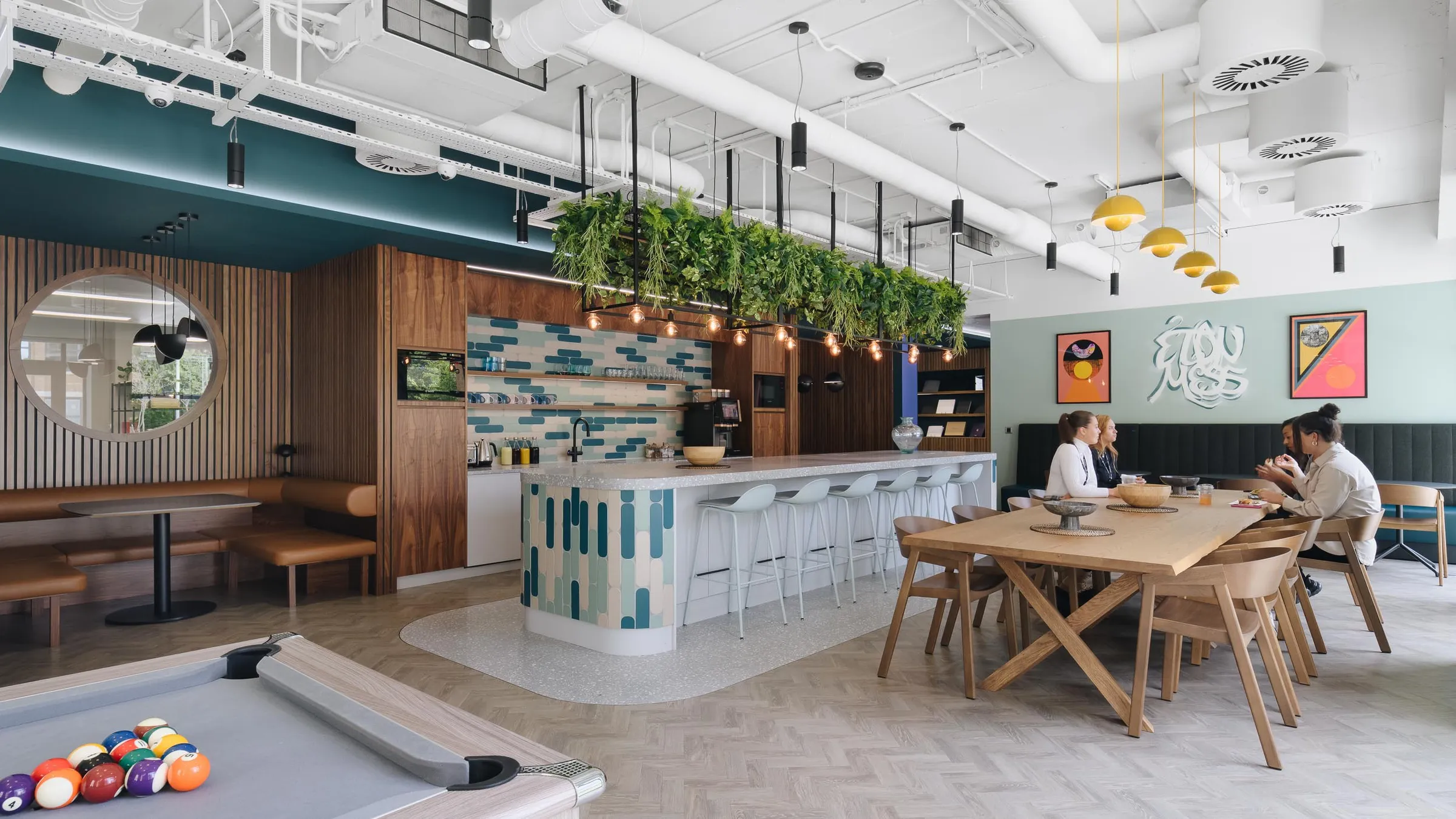Trends in Flexible Workspace Design
No matter where you work, the environment has a significant impact on your productivity, wellbeing, and ability to meet KPIs and reach goals. In this article, we’re taking a closer look at the facts and figures behind the flexible workplace design trends of today.
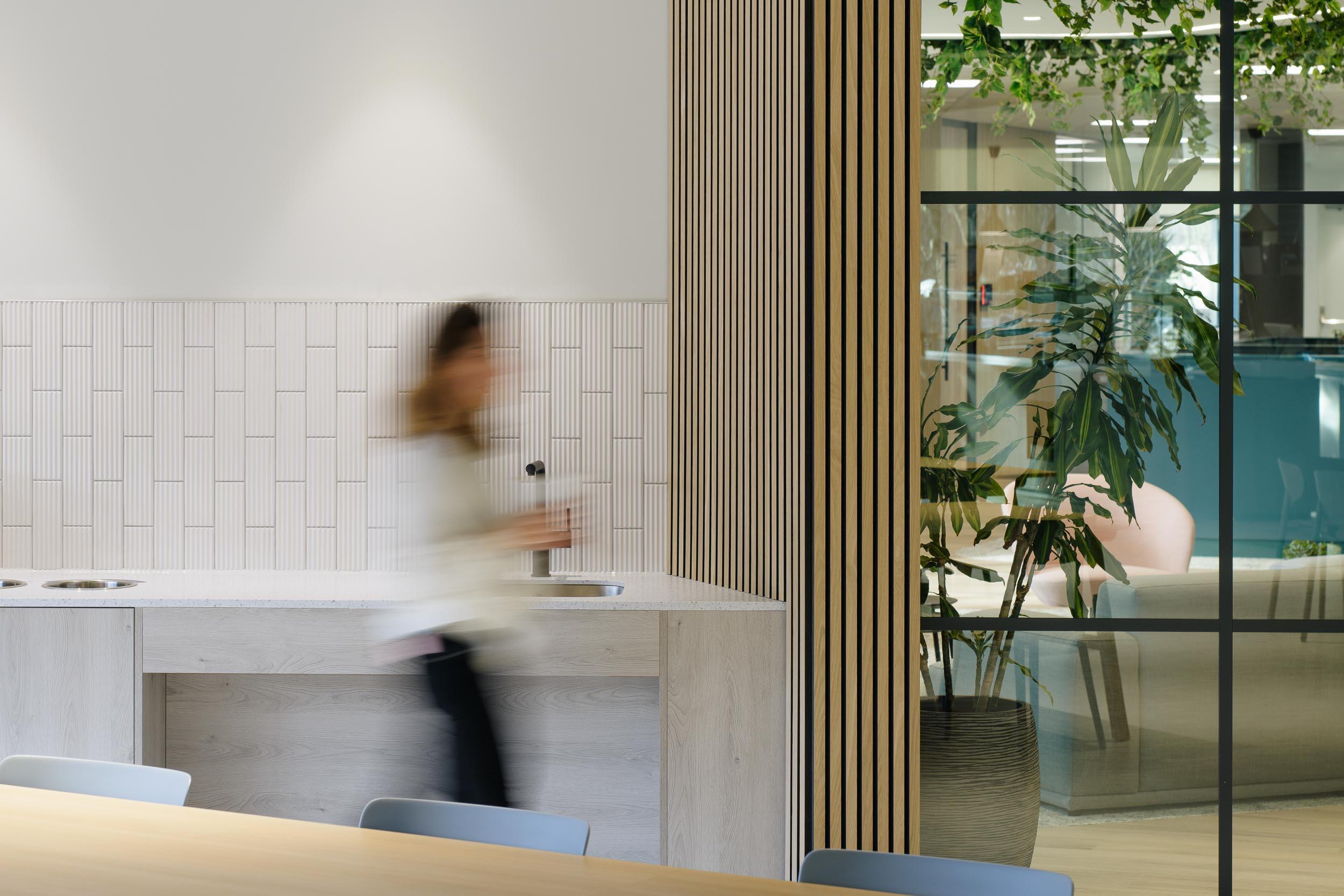

Written by
Fritha Selwyn Jones
Contents
In 2024-2025 91% of workers have a positive view of remote working. Pre-pandemic, the world was regulated by commuting to the office for work, working with your teammates together and then coming home. We never knew what would hit us in 2020 when the world ground to a halt and demanded us to adapt to new ways of working that many of us had never tried before. And now, having a flexible workspace is more common than not, with 60% of companies using a hybrid approach.
No matter where you work, the environment has a significant impact on your productivity, wellbeing, and ability to meet KPIs and reach goals. In this article, we’re taking a closer look at the facts and figures behind the flexible workplace design trends of today. Want a general office trend article? Read this one for a general outlook for all office types.
Top Flexible Workplace Design Trends
Hybrid-first Layouts
Hybrid Work Support: 2025 Office Design Trends that cater to both in-office and remote employees, ensuring seamless integration. Flexibility in 2025 means more than hot-desking—it means designing spaces that can physically adapt to the changing needs of individuals and teams throughout the day.
Reconfigurable workspaces are becoming a must-have for businesses managing hybrid teams. From folding walls and stackable furniture to modular tables and mobile workstations, design now enables teams to move seamlessly from focus work to collaboration, socialising or content creation—all within the same footprint.
Dedicated desks still serve some teams, but a balanced hot-desking approach maximises space efficiency while retaining continuity for those who need it. This type of hybrid-friendly environment is particularly effective for scale-ups and decentralised teams where agility is key.
Technology Integration
Digital infrastructure is now a fundamental part of the physical workspace, with smart technologies creating environments that are not only more efficient, but also more responsive to the needs of hybrid teams. From agentic AI to intelligent climate systems, the modern office is evolving into a highly adaptive ecosystem.
In flexible workspaces, this translates to:
Integrated booking systems that sync with calendars and occupancy data to streamline desk and meeting room use
Smart lighting and climate control that automatically adjust based on real-time usage and environmental data
Fully equipped collaboration zones with advanced AV setups to support seamless hybrid meetings and virtual presence
Furniture and fixtures are adapting as well. Features like wireless charging, integrated connectivity ports and ergonomic configurations are now standard expectations—key to delivering a smooth, productive experience for both in-office and remote workers.
Smart tech is no longer a future aspiration; it’s a core enabler of flexible, people-focused work environments.
Employee Well-being at the Forefront
Supporting employee well-being is no longer a nice-to-have—it’s a non-negotiable. As organisations embrace more flexible ways of working, there’s a growing recognition that the physical workspace must actively contribute to people’s health, comfort and sense of belonging. The focus has shifted from simply providing a place to work, to creating environments that enable individuals to feel supported, energised and valued.
Biophilic design is becoming a cornerstone of this approach. Bringing the outside in—through greenery, natural materials, and access to outdoor views—has been shown to reduce stress levels, improve concentration, and promote overall mental wellness. These natural elements also help reconnect employees with their surroundings, adding warmth and a sense of calm to the workplace.
Natural light is another critical factor. Maximising daylight not only reduces reliance on artificial lighting, but also improves mood, regulates circadian rhythms, and increases alertness throughout the day. Thoughtful design choices, such as open layouts and transparent partitions, can help ensure light reaches as much of the workspace as possible.
Physical comfort is being addressed through the widespread use of ergonomic furniture and adjustable workstations. Rather than adopting a one-size-fits-all approach, modern offices are offering choice, allowing employees to select seating, desk setups, and postures that best suit their body and work style. This autonomy is crucial in reducing fatigue and preventing long-term strain.
Mental well-being is also coming to the forefront. Quiet zones, wellness rooms, and spaces for reflection or mindfulness are being incorporated to support emotional balance. Whether someone needs a short break from a busy team environment or a place to decompress after a demanding task, these dedicated areas provide vital space to reset.
Most importantly, today’s workplaces are being designed with inclusivity in mind. The aim is to support a diverse range of needs and preferences—whether that means offering spaces for neurodiverse individuals, ensuring accessibility throughout the office, or simply giving people more control over how and where they work.
By designing for well-being, businesses are not just improving employee satisfaction—they’re fostering a culture of care, trust and long-term engagement.
Data demonstrates that evidence-based workplace design focused on human-centred functionality delivers measurable improvements in well-being, productivity, satisfaction, and performance. Find Sketch Studios office design refurbishment service to make sure your office reflects the needs of your employees and your brand.
Modular and Multi-functional Design
In a workplace landscape defined by change, adaptability has become essential. With teams growing, shrinking, collaborating and rotating between remote and in-office schedules, workspaces must be designed to flex accordingly. That’s where modular and multi-functional design comes into its own.
Rather than fixed layouts, businesses are embracing reconfigurable spaces that can evolve in real time. Meeting rooms can transform into breakout areas; open zones can be sectioned off for focus work or impromptu collaboration. Mobile workstations, folding partitions, and modular furniture allow teams to adjust their environment to suit the task at hand—whether that’s a brainstorming session, a quiet solo project, or a hybrid client meeting.
This level of flexibility supports both efficiency and autonomy. Teams aren’t confined to one way of working; instead, they’re empowered to shape their environment based on immediate needs. It also makes better use of square footage, ensuring that no space sits idle and that every corner of the office can serve multiple functions.
From a design perspective, the focus is on mobility, versatility and simplicity—elements that not only enhance daily operations, but also future-proof the workspace for whatever comes next. Modular design isn’t just practical; it reflects a mindset that values responsiveness, creativity and continuous evolution.
Sustainability and ESG Goals
Sustainability is no longer just a design preference—it’s a business imperative. Environmental, social and governance (ESG) goals are shaping how organisations approach their workspaces, and in turn, how designers and developers respond.
Materials with purpose: More offices are being built or refurbished using recycled, reclaimed or responsibly sourced materials. From acoustic panels made of ocean plastic to furniture built from repurposed timber, material choice now plays a significant role in a building’s environmental footprint.
Low-carbon construction: Clients and contractors alike are prioritising lower-emission build methods. Modular construction, carbon accounting, and locally sourced materials are becoming more common, with a strong focus on reducing impact throughout the project lifecycle.
Energy performance and efficiency: Efficient heating, ventilation and lighting systems—often powered by renewables or supported by smart technology—are now standard in high-performance buildings. Real-time energy monitoring, automation and daylight harvesting are being integrated to optimise usage and cut operational costs.
Working towards certification: Frameworks like WELL, BREEAM and LEED are guiding design choices, helping organisations demonstrate accountability and meet ambitious ESG targets. Achieving certification is not only good for the planet—it also enhances brand reputation and can positively influence employee and client perception.
What’s next?
Innovation in sustainable design is accelerating. Expect to see more circular economy thinking, embedded carbon tracking, and fully regenerative spaces that give back more than they take. It’s not just about minimising harm—it’s about designing for long-term environmental value.
Private and Collaborative Spaces:
Modern workspaces are no longer dominated by rows of desks or entirely open-plan layouts. Instead, they’re increasingly defined by balance—spaces that support both connection and concentration.
Collaboration is still essential, but it doesn’t require constant openness. Flexible zones for teamwork—such as huddle areas, breakout lounges or open meeting spaces—encourage creativity, problem-solving and social interaction. These areas are often dynamic and informal, designed to invite participation and spontaneity.
At the same time, privacy is being consciously reintroduced. Acoustic pods, enclosed focus rooms and quiet corners provide refuge from the buzz, allowing individuals to work uninterrupted or recharge. For neurodiverse team members or those working on complex tasks, these spaces are vital in reducing sensory overload and supporting deep focus.
The most effective office layouts are layered—offering variety and choice so people can move between modes of work depending on the task, their mood, or team dynamics. It's this thoughtful blending of private and shared environments that allows flexible workspaces to truly support productivity, comfort and inclusion.
Flexible Workplace Behaviour Worldwide
The global market for flexible workspaces is booming. According to market analysis, in 2022, it was valued at $43.23 billion and is expected to grow to $136 billion dollars by 2032. Flexible workspaces are It’s growing at a capital annual growth rate (CAGR) of 11.87% from 2022 to 2023. Of all regions, Pacific Asia is expected to grow the fastest due to the increasing number of small enterprises and freelancers in that region.
As of 2022, Europe is the world region with the most flexible workspaces, at approximately 4,169, with Asia coming in at an incredibly close second with 4,137. The chart below shows the dispersion of flexible workspaces by world region.
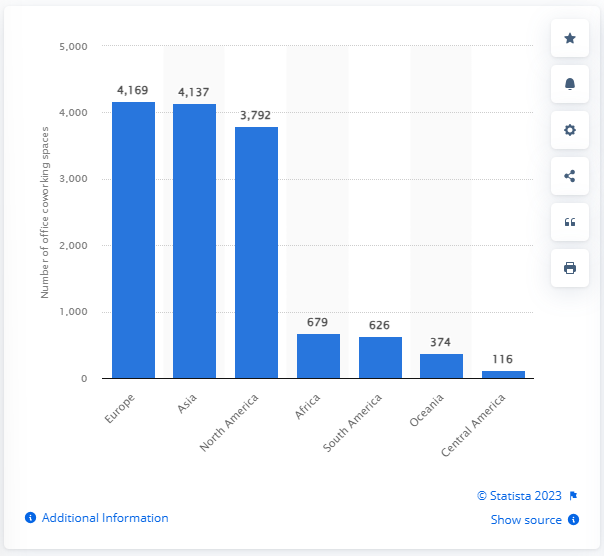
Image source: statista.com
Key players in the flexible workspace world are WeWork, Workspace, Awfis, SMARTWORKS, BizSpace, Servcorp, IWG, Garage Society, The Great Room, Pacific Workplaces
Increasing adoption of technology and innovation in digital ways of working were significant drivers for further expansion of the flexible working market. There was a surge in self-employment and the growth of the freelancer industry. Multinational companies also demanded more flexible offices. The demand for flexible working spaces has grown by 206% since the beginning of 2020, all around the globe.
In the UK, the Government has implemented more legislation on flexible working, making flexible working much easier. Flexible working has proven to boost productivity.
Flexible Workspaces and Productivity
Flexible working has become a defining feature of the modern workplace, and the data increasingly supports its value.
According to the Office for National Statistics (ONS), UK labour productivity (measured by output per hour worked) was 1.6% higher in Quarter 4 of 2024 than the pre-pandemic average. Output per worker also rose by 0.9% during the same period. These improvements are a clear indicator that new ways of working, including remote and hybrid models, are supporting sustained economic performance.
Nearly 28% of working adults in Great Britain were working in a hybrid pattern as of late 2024. This marks a steady shift from traditional office routines towards more flexible, results-driven approaches to work.
Research by Savills in 2019 onhow flexible working affects productivity revealed how the UK office layout and new working models have impacted employees even before the pandemic. Their findings were:
19% of participants preferred to work from home, with the majority surveyed (54%) saying they preferred flexible working. ⅓ of participants do not think their companies possess the right technology to allow them to work flexibly.
45% of workers thought hotdesking reduced their productivity, and just 12% thought it increased their productivity (the lowest rate in Europe). 60% preferred the familiarity of a desk that was permanently theirs, and only 3% favoured a shared desk.
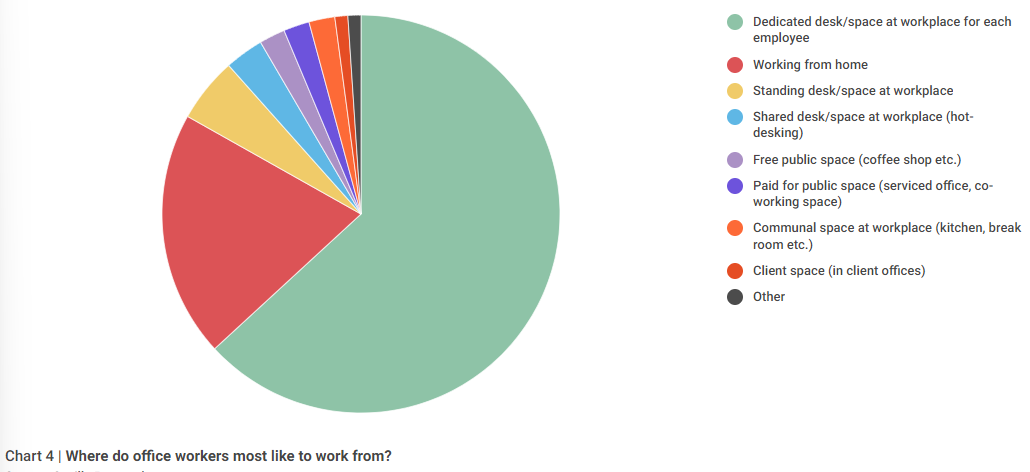
Image source: savills.co.uk
In the chart above, 19% of those surveyed said they preferred to work from home. But more modern data suggests it is closer to 44% now, a sharp increase in the last 5 years. So what are some of the benefits people get from working from home?55% say they focus better when working at home.
80% can accomplish all their tasks remotely.
33% cite the savings they make working from home as a big benefit.
34% said they can look after pets, children, and ageing relatives more easily.
25% cite improved health (physical, mental, and/or spiritual) as a benefit.
18% enjoyed the freedom to travel and relocate that remote working afforded them.
Those most likely to work from home are high earners. 38% of workers earning £40,000 or above hybrid worked during the survey period in 2022. But only 8% earning up to £15,000 reported the same. This is likely due not only to space and resources at home making work more comfortable but types of jobs that allow working from home.
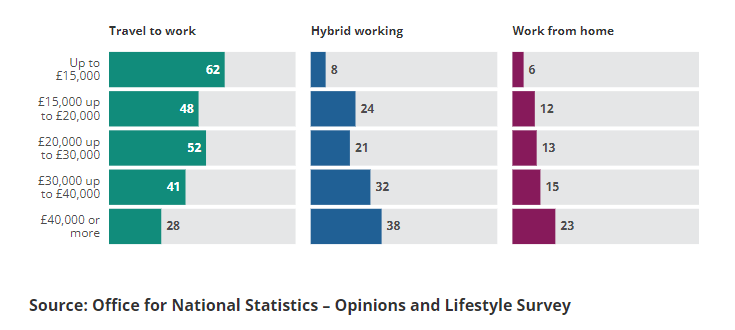
Image source: ons.co.uk
There are some downsides, too, though.
60% reported feeling less connected with colleagues.
30% found it difficult to separate their work lives from their home lives.
Surveyed workers said the biggest challenge when working from home was the struggle to ‘unplug’ and the difficulties in collaboration.
The Adoption of Flexible Workspace Designs
In 2019, Gensler and the British Council of Offices (BCO) together investigated flexible workspaces in the corporate sector in the UK, finding that 40% of those using flexible workspaces would rather work in conventional office space. However, a year later, in a 2023 study 98% of people said they would like to be able to work flexibly. This makes it much easier for companies to scale with flexible office spaces. So, what design factors play into how flexible and conventional workspaces are perceived and the effect they have on work?
With more companies providing coworking areas to their staff, collaborative and shared spaces were rated as the best types of workspaces in the study. 69% agreed their workplace helped them collaborate more with coworkers, and 57% reported being happier using flexible workspaces. However, just 29% felt flexible workspaces contributed to increased efficiency.
Gensler and the BCO determined that flexible workspaces needed to address both personal preferences and a range of different work settings, particularly those that offered more privacy than open-plan offices. Small businesses and freelancers suit the style of working in flexible offices compared to larger, more settled companies who have a stricter structure and need more from their offices.
It was noted that companies adopt flexible workspaces to transform business processes, pull pace with industry trends, and foster collaborations, employing at least one of these five models:
“Individual membership to a coworking space
External agile project space
Private office space in a coworking area
Flexible space in the company’s office
Alliance with a service provider.”
The report concluded with the following predictions about future flexible workplace trends:
“The future workplace will be more of a service and experience than a product.
Data will play a huge role in bringing together experience, space, and social dynamics contributing towards productivity
There will be a rise in hospitality-driven workplaces that prioritise amenities and convenience
The workplace will be seen as a place for up-skilling and creative problem-solving
Given the ongoing geopolitical shifts, there will be a rise in globally connected flex spaces as a wider platform of touchpoints that allow corporations to have a presence in new markets without setting up a base.”
The Design of Coworking Spaces
According to the Global Coworking Survey, 400% of coworking spaces are profitable though very few break even in the first few months of opening. Let’s look at some design factors that play into coworking spaces, according to Drop Desk:
60% of global coworking space users use assigned seats. The use of meeting rooms is at 30%.
On average, coworking spaces reserve 50% of their space for open-plan desk space and 25% for meeting rooms, break areas, and amenities.
51% of spaces have private areas for calls and remote meetings.
58% of spaces are furnished with modular walls and configurable layouts.
Over 75% of spaces have a central hub for meetings and gatherings.
60% feature biophilic elements, including plant life, natural lighting, and natural materials.
60% of desks are assigned, 30% are flexible use, and 8% are reservable.
In recent times, with the growing popularity of coworking, providers have started tailoring their spaces not only to corporate workers but artists, craftspeople, musicians, and even chefs.
What about the way a workspace is laid out? The shift away from conventional workspace design alongside flexible working has opened up more possibilities for providing a physical space that meets workers’ needs rather than a traditional workspace.
A study on flexible workspace design and ergonomics training looked at responses from computer users who received a mixture of flexible workspaces (adjustable desks, chairs, and so on) and ergonomics training (being taught new ways to work that are better for the body) against a control group. Metrics including mental wellbeing, feelings of job satisfaction and connectedness to coworkers, as well as physical comfort, were measured.
Results showed that flexible workspaces and ergonomics training resulted in significant improvements in all metrics. The most significant control factors were workspace, lighting, privacy, job control, collaboration, corporate culture, ergonomic climate, and communication.
Flexible workspaces are here to stay and have proven to revolutionise the way we work in the modern world. With the adoption of more innovative technology, collaboration across cities, countries, and continents, and with employee wellbeing more important than ever, we think it’s essential that flexible working is seized. Flexible workspace design should be approached with careful consideration, creativity, and an open mind. If you have a flexible workplace project in mind, talk to Sketch Studios about making it a reality.
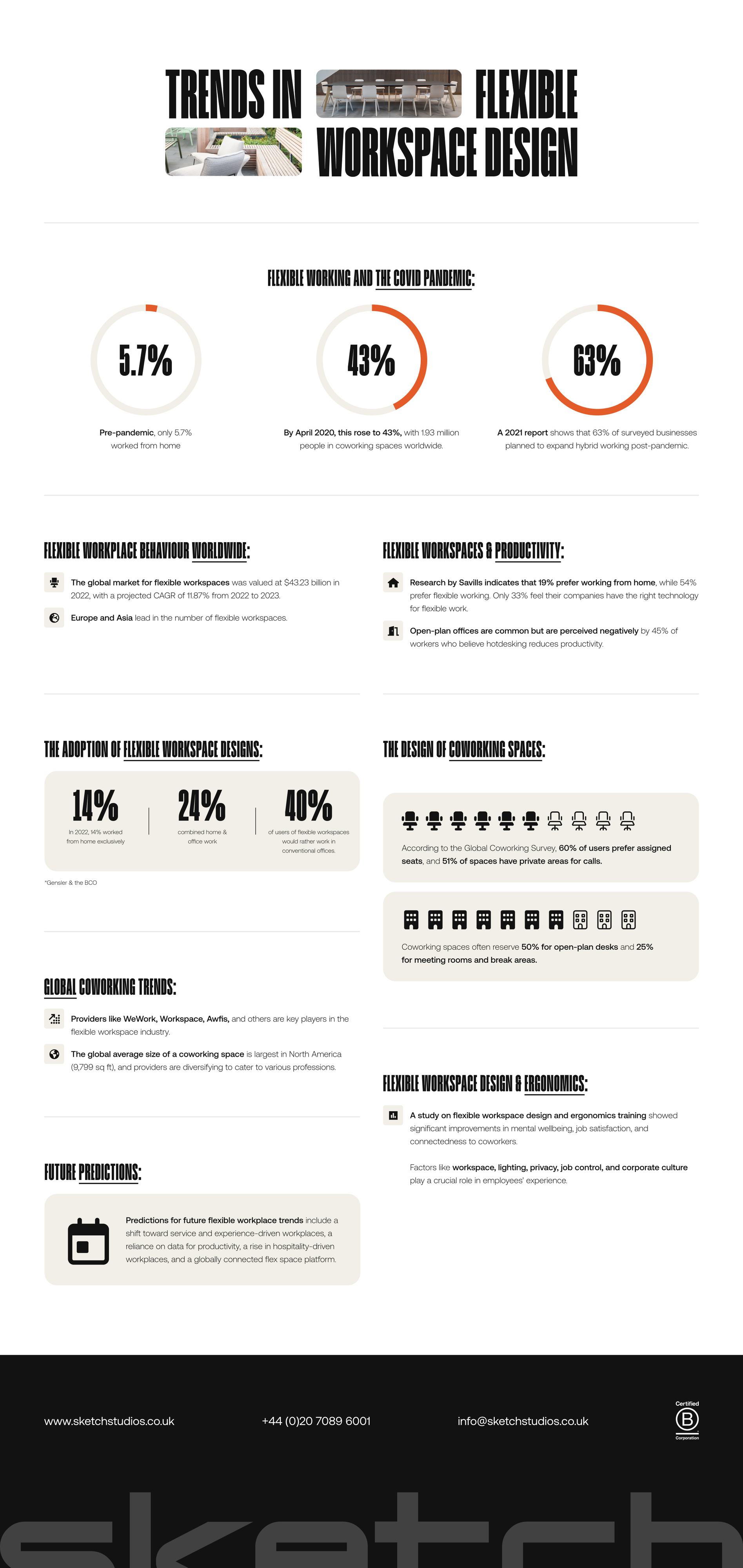
Flexible Working, The Covid Pandemic, and The Last 5 Years
In January of 2020, just 5.7% of us worked from home. By April, that number was 43%, with 1.93 million people in coworking spaces worldwide. Staying around the 44% mark in 2025, with a mixture of hybrid and full-time remote workers.
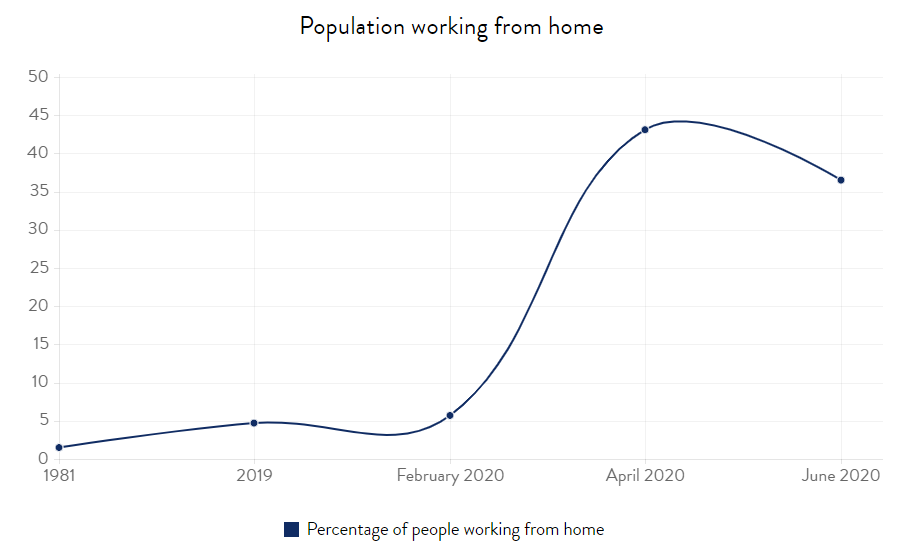
Image source: thehomeofficelife.com
We’ve come a long way since the days of lockdown, and now many businesses have adopted flexible working, seeing the merits of allowing employees more freedom with how they show up to work.
The evolution of flexible working: 2020 to 2025
Flexible working has undergone a remarkable transformation since the pandemic first pushed businesses to reconsider traditional office models.
A reactive shift in 2020 laid the groundwork
In January 2020, only 5.7% of the UK workforce worked from home regularly. By June of that year, in response to the first national lockdown, that figure had skyrocketed to 38% in the UK. Flexible working rapidly became a necessity rather than a preference, with millions of workers adopting remote or hybrid routines for the first time.
Although many believed this would be a temporary shift, data from 2021 showed a decisive change in employer attitudes. A post-pandemic review revealed that:
81% of organisations had already implemented some form of hybrid working.
63% planned to expand their hybrid offerings.
Full-time remote working was on the agenda for 45% of employers.
Those that had no hybrid strategy pre-pandemic (25%) dropped to just 16% following it.
2022–2023: Hybrid work becomes the default
As commuting returned, so too did a reassessment of where and how work happens. By 2022, around 14% of workers were fully remote, while 24% balanced working from home with time in the office. The notion of a fixed, full-time return to the workplace began to fade.
By 2023, companies were seeing the benefits of long-term flexibility:
Businesses offering fully remote working grew headcount by 1.9% in Q2 2023.
Those with structured hybrid policies (1-4 days in-office) saw a 1.5% increase in growth.
This trend wasn’t just about convenience - it was tied to employee engagement, recruitment, and productivity. Hybrid policies became a competitive advantage, driving demand for office spaces that could flex in sync with changing patterns.
2024–2025: A maturing model and the rise of the purposeful workplace
By the beginning of 2024, 62% of UK employees had the option to work from home on a regular basis , and the flexible working landscape became more formalised when legislation came into effect granting employees the right to request flexible working from day one.
In 2025:
16% of workers are fully remote.
44% were working in hybrid arrangements—now the dominant model across most industries.
- Regional and generational patterns also emerged. Flexible work was most common in the South East (35%) and London (30%), with lower uptake in the North East (19%).
Hybrid working peaked among 35 - 44 year olds (35%) and remained lowest among 16–24 year olds, 65% of whom commuted daily without homeworking options.
What this means for workplace design
The data is clear: flexible working is here to stay, but it's also evolving. The office now plays a more strategic role, acting as a hub for collaboration, innovation, and brand identity rather than routine desk work.
At Sketch Studios, our consultancy-led approach is built around helping organisations adapt to these realities. Whether it's designing for zoning, modular layouts, or tech-enabled collaboration, we translate emerging working patterns into practical, future-proofed design solutions.
From 2020’s remote scramble to 2025’s hybrid sophistication, we’ve seen how flexibility isn’t just a benefit - it’s a business imperative. The spaces you create now will determine how your teams work, connect, and thrive in the years ahead.
Published on
November 29, 2023
